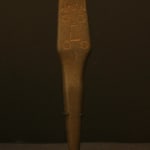Olmec Pointed Stone Pectoral, 900 BCE - 600 CE
Stone
6.75
PF.5589
Further images
The Olmecs are generally considered to be the ultimate ancestor of all subsequent Mesoamerican civilisations. Thriving between about 1200 and 400 BC, their base was the tropical lowlands of south...
The Olmecs are generally considered to be the ultimate ancestor of all subsequent Mesoamerican civilisations. Thriving between about 1200 and 400 BC, their base was the tropical lowlands of south central Mexico, an area characterized by swamps punctuated by low hill ridges and volcanoes. Here the Olmecs practiced advanced farming techniques and constructed permanent settlements, including San Lorenzo Tenochtitlán, La Venta, Tres Zapotes, Laguna de los Cerros, and La Mojarra. However, the consolidation of their city-states led to notable cultural influence far beyond their heartland, and throughout the Mesoamerican region. This was confirmed in 2005 with the use of NAA (Neutron Activation Analysis) and petrography to demonstrate the spread of Olmec ceramic vessels. It would appear that the Olmec style became synonymous with elite status in other (predominantly highland) groups, with evidence for exchange of artefacts in both directions. A non-literate group, the Olmecs nevertheless paved the way for the development of writing systems in the loosely defined Epi- Olmec period (c. 500 BC). Further innovations include arguably the first use of the zero, so instrumental in the Maya long count vigesimal calendrical system. They also appear to have been the originators of the famous Mesoamerican ballgame so prevalent among later cultures in the region, and either retained or invented several religious symbols such as the feathered serpent and the rain spirit, which persisted in subsequent and related cultures until the middle ages.
Comparatively little is known of their magico-religious world, although the clues that we have are tantalising. The art forms for which the Olmecs are best known, the monumental stone heads weighing up to forty tons, are generally assumed to pertain to some form of kingly leader or possibly an ancestor. The smaller jade figures and celts of which this is one are believed to be domestically or institutionally based totems or divinities. The quality of production is astonishing, particularly if one considers the technology available for production, the early date of the pieces, and the dearth of earlier works upon which the Olmec sculptors could draw. Some pieces are highly stylised, while others demonstrate striking naturalism with interpretation of some facial features (notably down-turned mouths and slit eyes).
Carved to resemble a hybrid snake/bird, this mysterious pendant most likely belonged to a shaman, the religious and spiritual guides of ancient Mesoamerican cultures. What was it used for? Perhaps ceremonial or ritual purposes. The holes perforated into the sides of the carving, just before it tapers off into a point, would have allowed it to be worn as a pendant or pectoral. The shaman kept this device close to him, attesting to its worth and importance. The actual piece is an extraordinary example of the artistic achievements of the Olmec civilization. The smooth stone is finely polished and the handle fits comfortably into our palm. The inscribed decorative carvings on the handle are abstract symbols of geometric patterns that can be dually interpreted as both aviary and serpentine. The composite creation of mythological creatures was a common phenomenon in Pre-Columbian religious beliefs. Above all, this outstanding object represents a link to the mysteries of the past. The shaman was probably the only individual who was aware of its true powers.
Comparatively little is known of their magico-religious world, although the clues that we have are tantalising. The art forms for which the Olmecs are best known, the monumental stone heads weighing up to forty tons, are generally assumed to pertain to some form of kingly leader or possibly an ancestor. The smaller jade figures and celts of which this is one are believed to be domestically or institutionally based totems or divinities. The quality of production is astonishing, particularly if one considers the technology available for production, the early date of the pieces, and the dearth of earlier works upon which the Olmec sculptors could draw. Some pieces are highly stylised, while others demonstrate striking naturalism with interpretation of some facial features (notably down-turned mouths and slit eyes).
Carved to resemble a hybrid snake/bird, this mysterious pendant most likely belonged to a shaman, the religious and spiritual guides of ancient Mesoamerican cultures. What was it used for? Perhaps ceremonial or ritual purposes. The holes perforated into the sides of the carving, just before it tapers off into a point, would have allowed it to be worn as a pendant or pectoral. The shaman kept this device close to him, attesting to its worth and importance. The actual piece is an extraordinary example of the artistic achievements of the Olmec civilization. The smooth stone is finely polished and the handle fits comfortably into our palm. The inscribed decorative carvings on the handle are abstract symbols of geometric patterns that can be dually interpreted as both aviary and serpentine. The composite creation of mythological creatures was a common phenomenon in Pre-Columbian religious beliefs. Above all, this outstanding object represents a link to the mysteries of the past. The shaman was probably the only individual who was aware of its true powers.





